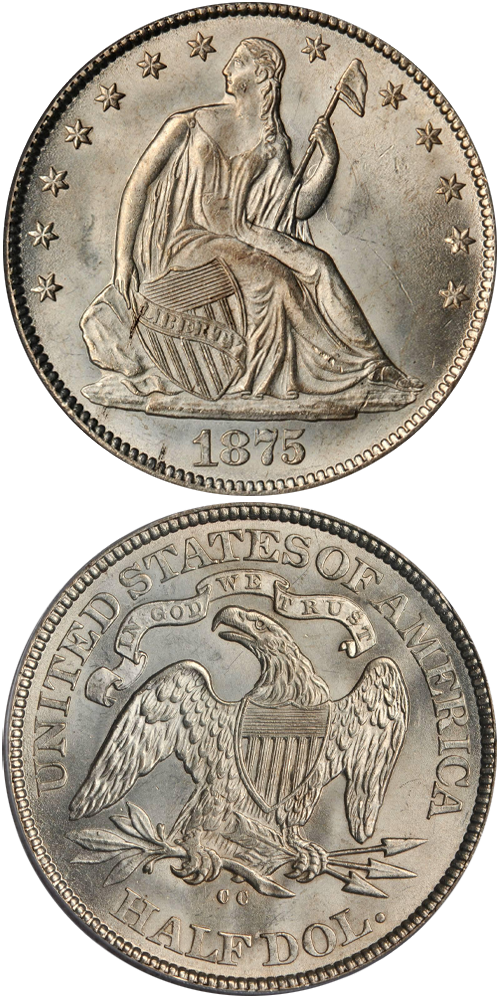1875-CC Liberty Seated Half Dollar
Jeff Ambio: All 1875 dated Liberty Seated half dollars (Philadelphia, Carson City and San Francisco mints) were struck from dies produced using a defective date logotype punch that imparted a tiny defect to the upper right corner of the base of the digit 1. This defect is not evidence of a Repunched Date variety.
Of the nine obverse dies identified for the 1875-CC issue, the one used as part of the WB-10 marriage is readily identifiable by the presence of a heavy die line from the ball of Liberty's foot that extends into the rock support. There is also a small die lump in the drapery behind Liberty's heel and a weak center dot in Liberty's lap. This obverse was used to strike examples of both the WB-9 and WB-10 die pairs.
All reverse dies of the 1875-CC half dollar exhibit a Medium CC mintmark. Reverse D (per the nomenclature assigned by Bill Bugert in the 2010 book A Register of Liberty Seated Half Dollar Varieties, Volume II, Carson City Branch Mint) is known in only one marriage, WB-10. It is easiest to attribute by looking for a small die lump near the upper edge of the middle leaf on the olive branch.
Rusty Goe: Director of the Mint Henry R. Linderman accompanied Robert Empie Rogers, a trained chemist and metallurgist, to Nevada's Comstock region in July 1875 to inspect the most productive mines. Two years into the Big Bonanza period, Linderman desired to know how much more ore that area could produce. Rogers concluded that the Consolidated Virginia and California mines alone could yield $300 million, but "to guard against the chance of overestimating," he placed the future "production at not less than $150 million." Director Linderman, "having official business at the Carson Mint," paid another visit to the Comstock at the end of August. Using Professor Rogers's calculations and his own premonitions, Linderman ascertained that "the total production of all the mines on the Comstock may be safely estimated at not less than fifty million dollars per annum...."
New energy was pumped into operations at the Carson City Mint in 1875, such as that facility had never experienced before. Whereas workers there had delivered nearly 1.6 million coins in 1874 (86 percent of which were trade dollars), they pushed themselves to the limit in 1875 and rammed slightly more than 7.6 million through their two presses.
Of that total, half dollars accounted for 13 percent. The year's half dollar mintage was 1,008,000 pieces -- the first of three consecutive annual runs of a million plus.
From 1870 through 1874 the Carson Mint had struck 862,627 half dollars (depending on whose figures we use). My top estimate for the aggregate total of surviving specimens from those first five years is about 2,000. Curiously, despite its substantially higher mintage figure, my top estimate for the surviving population of 1875-CC half dollars is 2,000. Still much more plentiful than any of the individual issues from the preceding five years, but not as abundant as the original output might suggest.
Q. David Bowers: Rusty Goe estimates that 80 to 100 1875-CC half dollars survive in Mint State plus 200 to 300 in EF to AU grade, and 1,000 to 2,000 overall. In just about any preservation desired an example is easy enough to find, although choice and Gem pieces are slightly scarce.
Wiley and Bugert found 13 different die combinations resulting from the pairing of nine obverse dies with eight reverses. One of the reverses, described as WB-102, has the first C in the mintmark punched over a smaller earlier C.
The example to the left was sold by Stack's Bowers Galleries in the August 2012 Battle Born Collection of Carson City Coinage, where it realized $8,812.






